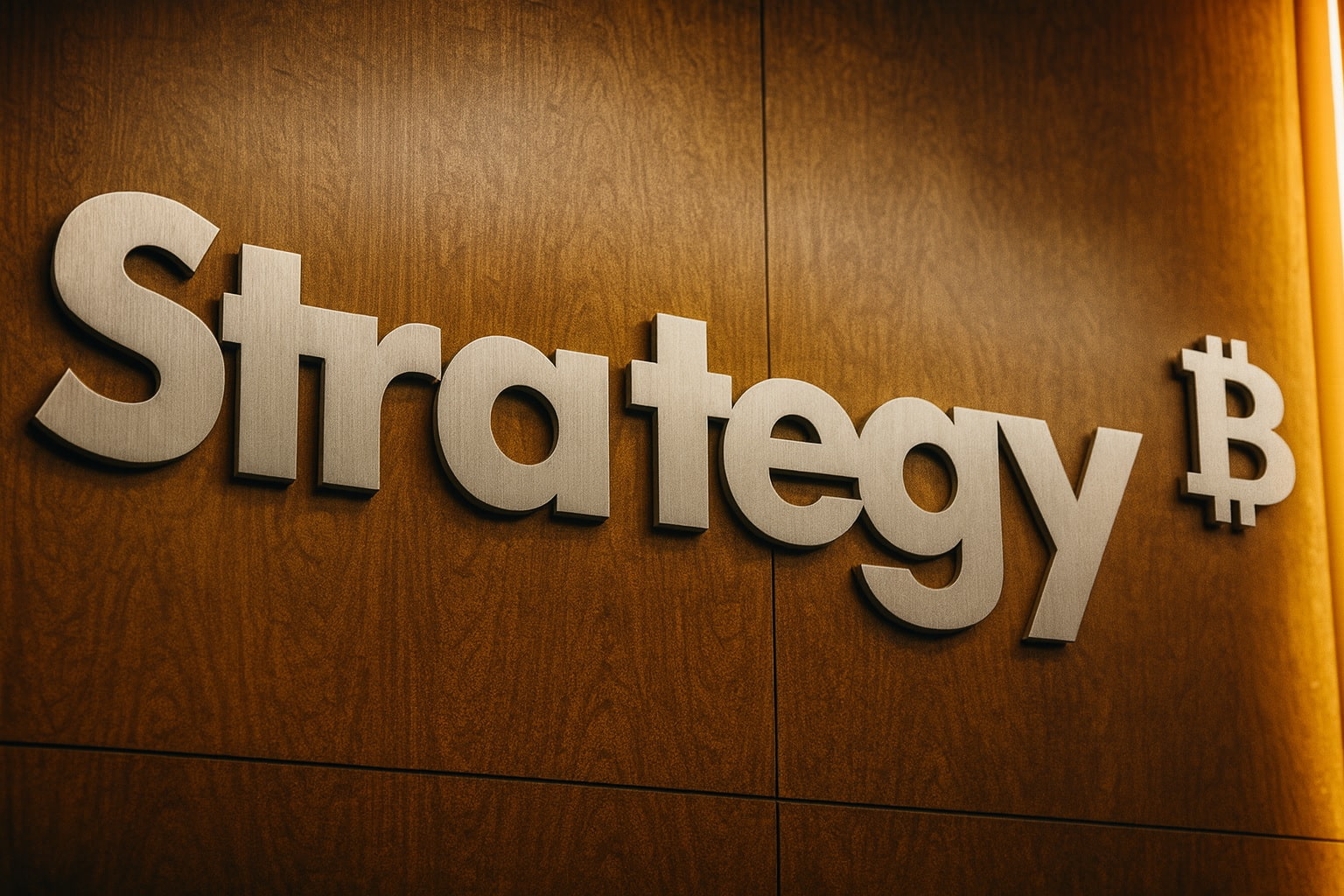Bitcoin may be stuck in its deepest correction of 2025, but Michael Saylor is leaning in, not backing out.
Over the past week, Strategy Inc. (MSTR) — the enterprise software company turned Bitcoin mega‑holder led by executive chairman Michael Saylor — acquired 8,178 BTC for about $835.6 million, its largest weekly buy since July. [1]
At the same time, Saylor has a clear message for nervous investors watching Bitcoin bleed: HODL.
Key facts at a glance
- New purchase: 8,178 BTC bought last week for $835.6 million, at an average price near $102,171 per coin. [2]
- Total stash: Strategy now holds 649,870 BTC, acquired for roughly $48.37 billion (average cost around $74,400 per BTC). [3]
- Market value: At current prices around $94,000–$96,000, the hoard is worth roughly $62 billion. [4]
- Funding source: The new purchases were primarily financed via euro‑denominated and U.S. preferred share offerings, after a sharp slide in Strategy’s common stock price. [5]
- Backdrop: Bitcoin is down about 25% from its October all‑time high, short‑term holders are heavily underwater, and BTC briefly traded around $93,684 over the weekend. [6]
Strategy’s Biggest Bitcoin Buy Since July
According to a Monday filing with the U.S. Securities and Exchange Commission, Strategy disclosed that it had bought $835.6 million worth of Bitcoin in the seven days ending Sunday, taking advantage of the latest leg down in the crypto market. [7]
CoinDesk reports that the company accumulated 8,178 BTC during that period, paying an average of roughly $102,171 per coin. [8] This marks a return to “mega‑sized” purchases after several months where Strategy’s buys were comparatively modest — sometimes just a few hundred coins at a time. [9]
With the new haul, Strategy’s balance sheet now includes 649,870 BTC, making it by far the largest publicly traded corporate holder of Bitcoin. Bloomberg estimates that stash is worth around $61.7 billion at today’s prices. [10]
From a cost perspective, the company has spent about $48.37 billion on its Bitcoin campaign overall, giving it an average acquisition price in the mid‑$70,000s — still comfortably below current spot levels even after the recent drawdown. [11]
Why Saylor Is Using Preferred Shares, Not Common Stock
One of the most interesting parts of this latest buying spree is how it’s being financed.
CoinDesk notes that Strategy has become “hamstrung” in its ability to sell more common shares because its stock price has fallen roughly 56% over the past four months, making further common issuance increasingly dilutive. [12]
Instead, Saylor and his team leaned on preferred stock:
- A euro‑denominated preferred share offering (ticker STRE) aimed at European investors raised around $715 million earlier this month.
- Additional capital came from the STRC preferred series, adding about $131.4 million, according to a Monday filing. [13]
Bloomberg reports that most of the $835.6 million in Bitcoin buys appears to have been funded from these preferred offerings, allowing Strategy to keep expanding its BTC war chest without issuing more common stock at depressed prices. [14]
The trade‑off is clear:
- Pros:
- Strategy keeps its “Bitcoin accumulation” narrative alive.
- Common shareholders avoid immediate heavy dilution.
- Cons:
- The company takes on fixed obligations and a more complex capital structure.
- Its balance sheet becomes even more tightly coupled to Bitcoin price volatility.
With the stock now trading near the value of its Bitcoin holdings alone, Strategy increasingly looks like a leveraged, actively managed Bitcoin holding vehicle with a software business attached. [15]
Saylor’s Message to Bitcoin Investors: Volatility Is the Price of Admission
Before today’s headline‑grabbing purchase became public, Saylor was already in the spotlight.
As Bitcoin slid below $95,000 last week — erasing most of its year‑to‑date gains — social media lit up with rumors that Strategy might be selling, challenging Saylor’s long‑standing “never sell” stance. [16]
According to an in‑depth report from Investopedia, Saylor quickly pushed back on those fears: [17]
- He dismissed the rumors that Strategy was offloading Bitcoin.
- He posted a meme on X (formerly Twitter) showing himself on a life raft watching a ship burn, captioned simply “HODL” — a visual reminder of his insistence on riding out volatility.
- In a CNBC interview, he said Strategy had been “buying quite a lot” of Bitcoin recently and reiterated his view that the asset will outperform both gold and the S&P 500 over the long term. [18]
At the same time, he pulled back from making precise short‑term price targets, acknowledging that the speed and depth of the recent selloff makes end‑of‑year forecasting tricky. [19]
Still, his core message hasn’t changed: Bitcoin is a multi‑decade bet, and turbulence is part of the journey.
Bitcoin’s Deep Correction: Most Recent Buyers Are Underwater
Saylor’s aggressive dip‑buying comes as on‑chain data turns increasingly painful for short‑term traders.
A separate CoinDesk analysis, using Glassnode data, shows: [20]
- 2.8 million BTC held by short‑term holders (STHs) — entities that have held coins for less than 155 days — are now at a loss.
- That is the largest underwater STH position since the FTX collapse in late 2022, when Bitcoin traded near $15,000.
- Bitcoin is down roughly 25% from its October 2025 all‑time high, a pullback that still fits within the “typical” range for a bull‑market correction (historically in the 20–30% zone).
Interestingly, the pressure is not coming from U.S. spot Bitcoin ETFs:
- U.S. spot BTC ETF assets under management are only about 3–4% below their peak, slipping from roughly 1.38 million BTC to 1.33 million BTC.
- Measured in BTC rather than dollars, ETF holdings remain close to their all‑time highs, suggesting ETF investors are largely staying put. [21]
Instead, much of the selling seems to be driven by long‑term holders taking profits. Glassnode’s data indicates that long‑term holder supply has dropped by around 452,000 BTC since July, as some early adopters cash out after years of accumulation. [22]
Macro and Liquidity: Why the Selloff Feels So Brutal
Beyond Bitcoin‑specific flows, the broader macro and market structure backdrop has turned hostile:
- Federal Reserve expectations have shifted. CoinDesk’s “Crypto Markets Today” notes that odds of a December rate cut now hover around 50%, a wobble that has undermined risk sentiment rather than providing clear relief. [23]
- Liquidity is thin. Futures open interest has been sliding across major tokens, while options positioning on Deribit shows a strong tilt toward puts and downside protection, with front‑end BTC implied volatility climbing above 50% annualized. [24]
- Altcoins have been hit even harder. Tokens like Solana and privacy coins such as Zcash have retraced deeply from recent highs, and the crypto fear‑and‑greed index is flashing “extreme fear” at 17/100, its lowest reading since April. [25]
Reuters adds that over the weekend Bitcoin fell nearly 2% to about $93,684, underscoring just how fragile support levels have been in recent sessions. [26]
In other words, Saylor isn’t buying a gentle dip — he’s stepping into a market where morale is shaken, leverage is coming out, and many traders are nursing steep losses.
What Strategy’s $835M Bet Means for Its Shareholders
For Strategy shareholders, today’s news cuts both ways.
On the bullish side:
- The company is doubling down on its identity as a Bitcoin‑first treasury vehicle.
- If Bitcoin recovers and pushes beyond its October highs, the embedded leverage from preferred financing could supercharge equity returns.
- Saylor’s consistency — rhetorically (“HODL”) and operationally (keep buying) — reinforces the brand among Bitcoin maximalists. [27]
On the risk side:
- Strategy’s enterprise value now sits close to the value of its Bitcoin holdings alone, meaning the core software business is almost a “free add‑on” — but also that shareholders are heavily exposed to Bitcoin’s price path. [28]
- The company has layered on preferred stock obligations that still need to be serviced even if Bitcoin enters a longer, deeper drawdown. [29]
- With the stock down more than 50% from recent highs, volatility in MSTR can be even more brutal than volatility in BTC itself, especially during forced deleveraging phases. [30]
For investors, the practical takeaway is that owning Strategy shares is not simply “owning some Bitcoin.” It’s owning leveraged Bitcoin exposure plus company‑specific financial engineering, which can amplify gains — and losses.
What This Means for Crypto Investors Right Now
Whether you cheer Saylor’s conviction or see it as reckless, today’s developments crystallize several key themes for anyone watching Bitcoin:
- Whales are still buying the dip.
Strategy’s $835M purchase shows that at least one major corporate player still views prices near $95,000 as attractive in a long‑term framework. [31] - Short‑term pain is real — especially for late entrants.
With 2.8 million BTC held at a loss by recent buyers, on‑chain data confirms that many are underwater and feeling the heat, increasing the risk of capitulation. [32] - Institutional vehicles are proving sticky.
U.S. spot Bitcoin ETFs have seen only modest BTC outflows relative to the price decline, suggesting that much of the “tourist money” may already have left earlier in the year. [33] - Macro still matters.
Shifting expectations around Fed policy and thin liquidity have turned a normal bull‑market correction into a psychologically intense drawdown, particularly for leveraged players. [34] - Saylor’s playbook is not for everyone.
Strategy’s approach — heavy leverage, long‑duration horizon, and willingness to ride out brutal volatility — assumes extreme risk tolerance and access to capital markets that most individual investors simply don’t have. [35]
As always, none of this is financial advice. Anyone considering exposure to Bitcoin or Bitcoin‑linked equities like Strategy should assess their own risk profile, time horizon, and diversification needs before following a billionaire into the storm.
References
1. www.bloomberg.com, 2. www.coindesk.com, 3. www.coindesk.com, 4. www.bloomberg.com, 5. www.coindesk.com, 6. www.coindesk.com, 7. www.bloomberg.com, 8. www.coindesk.com, 9. www.coindesk.com, 10. www.bloomberg.com, 11. www.coindesk.com, 12. www.coindesk.com, 13. www.coindesk.com, 14. www.bloomberg.com, 15. www.coindesk.com, 16. www.investopedia.com, 17. www.investopedia.com, 18. www.investopedia.com, 19. www.investopedia.com, 20. www.coindesk.com, 21. www.coindesk.com, 22. www.coindesk.com, 23. www.coindesk.com, 24. www.coindesk.com, 25. www.coindesk.com, 26. www.reuters.com, 27. www.investopedia.com, 28. www.coindesk.com, 29. www.coindesk.com, 30. www.coindesk.com, 31. www.bloomberg.com, 32. www.coindesk.com, 33. www.coindesk.com, 34. www.coindesk.com, 35. www.investopedia.com










